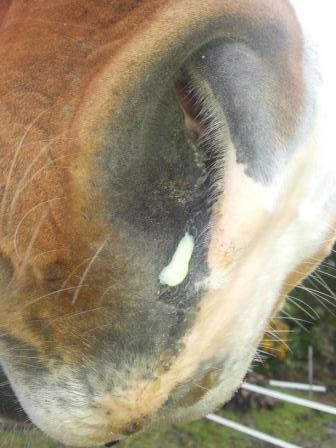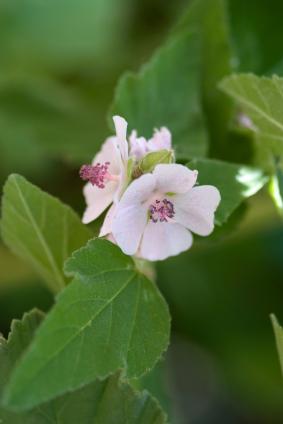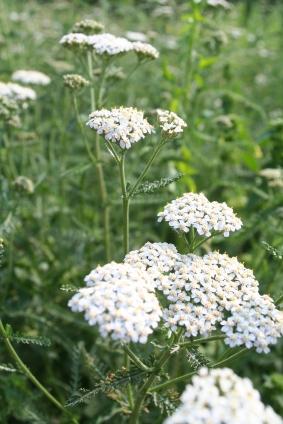Horsezone News
Healing Respiratory Ailments Naturally - Part 1
By: © Victoria Ferguson Dip.Herb.Med.
 |
 |
| Elecampane |
 |
| Marshmallow |
 |
| Yarrow |
Respiratory ailments are the most common cause of illness and lack of performance in horses along with musculo-skeletal problems.
The function of the respiratory system is to conduct air to and from the cells of the lungs and to bring about gas exchange allowing the body to absorb oxygen into the bloodstream and to excrete carbon dioxide. The upper respiratory tract consists of a series of mucous lined membranes which channel air from the nostrils to the lower respiratory tract with the mucous acting as a protective. The lower respiratory system consists of trachea, bronchi and lungs which occupy a huge space in the abdomen of the horse. This is where the gas exchange occurs through the membranes of the capillaries lying very close to the air cells (alveoli) in the lungs. These delicate structures along with the tiny hairs which line the airways (cilia) are easily damaged.
Signs of respiratory problems include coughing, irregular breathing patterns, exercise intolerance and abnormal nasal discharge. It is normal for horses to have a small amount of clear nasal discharge at any time including after exercise.
In a horse with severely disrupted breathing, a distinct “heave line” will become obvious which follows the base of the ribs surrounding the lungs tracing upwards into the flanks.
The ailments which affect the respiratory system of the horse frequently recur if they are not properly healed in the first place and often worsen into conditions such as COPD or so called allergies.
If the immune system of the horse is properly cared for at all times and any respiratory ailment is completely healed, this will prevent chronic conditions developing. Unfortunately most horse owners and managers think that if the horse has no symptoms after a week of veterinary antibiotics, then all is well. This is usually NOT the case.
Respiratory ailments include coughs and colds, viral and bacterial infections, genuine allergies, sinusitis and bleeding.
If a horse has a cough, it is important to ascertain the cause, so that appropriate treatment can be given. A cough is usually associated with a cold either of viral or bacterial origin, an allergy or post-viral syndrome.
If the cough is associated with mucus discharge from the nostrils and/or throat, the cause is viral, bacterial or allergy. The horse should be rested, temperature and respiratory rate monitored and herbal treatment administered without delay.
A cough associated with a cold may mean that only the upper respiratory system has been affected and the lungs, the lower respiratory system, are not involved. Horses can be suffering from respiratory infection even if they are not coughing, other symptoms are elevated temperature, elevated respiratory rate, enlarged glands and raspy breathing.
To avoid recurring illness at a later date continue treatment after symptoms have gone. This is especially important in the case of respiratory ailments because of the need to heal tissue damage after the infection has gone. Remember the old adage “structure governs function”.
Management and nursing are of the utmost importance in the care of horse suffering from respiratory infections. They must be kept warm if the weather is cold, comfortable, out of the wind, stress free and if stabled, good ventilation is essential.
As with all health problems, prevention is better than cure, not to mention being less expensive and certainly less stressful to all concerned. To give your horses their best chance of resisting respiratory ailments through their own immune system, incorporate high rates of Rosehips into their daily feed.
I have always advocated feeding Garlic as part of the daily feed but the Garlic granules or powder available for horses on line or through feed stores is all imported from China, with the most questionable growing and processing conditions, so I can no longer use or recommend it.
Instead use Australian grown organic garlic which can be purchased on line direct from the growers. Locally grown garlic can be used, it may not be organic, but at least it is Aussie grown. The benefits of buying Garlic direct from the grower is that you can also use it for your own cooking and it truly is a culinary delight. Most horses will eat fresh quality Garlic especially if it is mixed with some raw honey for therapeutic purposes. Whereas a lot of them will not touch the Chinese rubbish. The same applies to Garlic in vinegar, as the same questionable garlic is used to make those products.
If any kind of respiratory illness is suspected immediately administer herbal first aid and obtain a herbal prescription or formula. If a veterinary antibiotic is given as a first line of defence, it is really good practice to follow up with a herbal treatment.
Specific herbs for respiratory infections are Elecampane and/or Olive Leaf, immune boosters Echinacea and Withania, cough supressants Sage, Thyme & Chamomile, as well as the soothing demulcent herbs Marshmallow and Liquorice, which is also an expectorant. Tissue repair herbs include Yarrow, Comfrey and Rosehips.
RESPIRATORY ALLERGIES
The amount of air that a horse can get into its lungs to utilise metabolically is of great consequence. Allergies also known as chronic obstructive pulmonary disease in horses have a serious negative effect on the capacity of the airways, causing breathing difficulties similar to asthma in humans. Causes of these symptoms include obstruction, narrowing of the airways, inflammation, excess mucous and infection causing fluid in the space between the lungs and the chest wall. They all to some degree reduce breathing capacity, intolerance to exercise and loss of performance.
The biggest difficulty in treating allergies is discovering the allergens involved in each case. The herbal method of treatment is to reduce the extreme reactions, while toning and balancing the respiratory, immune and lymphatic systems, rather than trying to isolate the horse from a long list of possible allergens. Anyone who has had allergy tests conducted will realise that it is impossible to prevent exposure in most cases, let alone ascertain them for sure. It is also important to understand that it is possible for any being to be allergic or intolerant to almost anything. Horses are no exception.
Veterinary treatment for allergies affecting the respiratory system is cortisone. If a horse suffers an extreme, acute allergic reaction affecting its ability to breathe, it is imperative that a vet is called urgently so that an injection of cortisone can be administered, which may very well be a lifesaver.
However medium to long term use of corticosteroid hormones is contra-indicated due to the fact that they suppress normal immune system function, weaken muscles, produce loss of muscle mass, mood swings, weakening of bone and degeneration of joints and tendons.
Another problem that results from chronic allergies is that tissue in the airways becomes damaged and prone to infection, so herbs for prevention of infection and for tissue repair are also needed.
There are many herbs to use to manage respiratory allergies including the herbs already mentioned. Homeopathic nosodes are another option for extreme cases.
Liquorice is particularly useful for horses whose allergies have had long term treatment with cortisone, as it stimulates the body’s own production of cortisol and can be used during a gradual weaning off the cortisone.
The appropriate combinations of herbs, dosage rates and treatment periods are important to achieve the best outcomes so please seek advice from a qualified equine herbal practitioner.
Next month: Treating Sinusitis and Bleeding (Epistaxis)
The team at Horsezone is excited to bring you informative articles from Victoria Ferguson Dip.Herb.Med., herbalist, horsewoman and author of The Complete Horse Herbal www.thecountryherbalist.com.au
News Search
Categories
- General
- Event Results
- Stallionzone
- Sponsored Shows
- Clubs
- Health
- Feature Horses
- Competitions
- Five Minutes With Horsezone
- Young Riders
- Reviews
- Training and Clinics
- Postcards from the saddle
- 2014 Equitana by HORSE FIRST
- 2013 Equitana
- 2012 Equitana
- 2012 London
- 2011 Equitana
- 2011 Queensland Floods
- 2010 WEG


